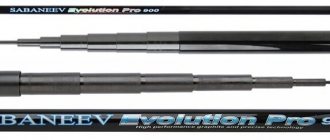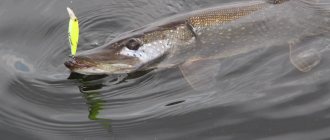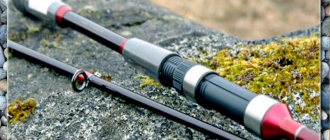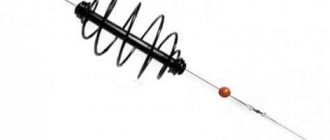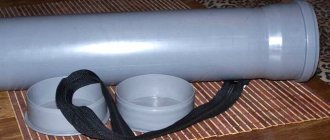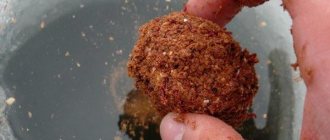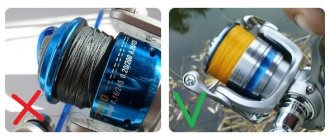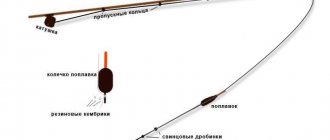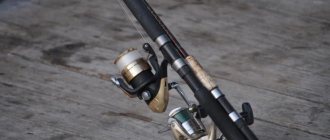Explanation of the term
The concept of “rod action” usually means how the blank reacts to the load applied to it (some anglers also add to this definition the speed with which the rod returns to its original shape when the load is removed). Under load, only the tip of the rod, the middle of the blank can bend, or the entire rod up to the butt can react. This characteristic affects the casting distance and accuracy, binding characteristics, and also makes it possible to speed up fishing if the blank is sufficiently rigid. In the case of spinning fishing, the formation also affects which baits can be used most effectively. We should also not forget that accuracy and range are largely subjective characteristics, which often depend more on the casting technique and experience of the fisherman than on the rod’s action itself.
Action is a universal concept for both feeder and spinning, float, and carp rods.
Fast build
In this case, approximately the upper third of the rod reacts to the load. The markings on such fishing rods are usually Fast, or simply F, this information is usually indicated next to the test and length of the rod. Such fishing rods give good control over the fish during the fishing process - you can lift the form and drag the trophy specimen over the edge, pull it out of the hole, or prevent it from going into snags, grass or reeds. But when fishing for a beginner, a fast rod will be of practically no help - in order to dampen the jerks of the fish, the bend of the upper third is clearly not enough, you will have to learn the correct setting of the clutch and the correct “pumping out” of large fish.
Casting with a fast blank can be mastered quite quickly by beginners; such fishing rods provide good accuracy from the very beginning, even without much experience on the part of the fisherman. The range is slightly less than slower options.
For beginners, it is quite possible to recommend rods with the Fast action, but it is advisable to master casting and landing fish, as well as adjusting the friction brake, under the supervision of more experienced fellow hobbyists.
Spinning test
An experienced fisherman, when choosing a new spinning rod, must pay attention to the inscriptions that are placed on the form of the rod. Many people do not understand what is written there and why it is needed. Usually they turn to the seller for help and clarification.
But, it is better to learn to understand all the parameters of a fishing rod on your own so that there are no problems with the purchase.
One of the important parameters is the spinning test, which is very important to consider when choosing any type of fishing rod.
The article will tell you in detail about what a test is, how to choose the right spinning test, and why it is needed at all.
What is a spinning test?
Such a characteristic as a test began to be taken into account when choosing a fishing rod not so long ago. In the last century, no one knew about it at all; even manufacturers produced spinning rods with ordinary aluminum tubes.
It was used to cast any type and weight of bait. The weight of the bait is very important, because the casting distance depends on it; light baits did not fly far.
Old models were not suitable for long casting.
Translated from English, “test” means “test”. It is necessary to determine baits that will be ideal for a particular spinning rod.
The test depends on the following nuances:
- Firstly, from the mass and elasticity of the rod whip;
- Secondly, on the type of guide rings on the rod and their placement;
- Thirdly, when choosing, be sure to look at the documents, which basically indicate the test of the selected spinning rod.
For example, you can find such an indicator as 20-30g , which means that such a spinning rod is designed for casting a spinner weighing 20-30 grams . The first number shows the minimum weight that can be used. Another number indicates the maximum weight; you cannot take more, otherwise the rod may be overloaded.
There is such a classification:
- The UL designation is an ultra-light class of spinning rod that can be used to cast bait weighing no more than 7 grams
- Designation L - light class of spinning rod, which is suitable for casting a spinner no more than 10 grams
- The designation ML is a medium-light class, the weight of the spinner is 4-17 grams
- Designation M - middle class spinning rod, bait weight 18-21 grams
- Designation MH - this is a medium-heavy class, casting bait 28 grams
- Designation H - heavy class, you can throw bait weighing 35-40 grams
- The designation XH is a super-heavy class; use bait weighing more than 42 grams.
How to choose the right spinning rod?
If you don’t want to worry about choosing a spinning rod, then you can take a universal option - length 2.4 meters, and test - 5-24 grams. This is the best option for beginners. But every fisherman should have several types of fishing rods available, with different test and action, which will be ideally suited to certain characteristics of the reservoir.
A universal spinning rod is the best option; it is suitable for fishing from the shore or from a boat. The test allows you to use almost all types of baits. But light baits will not fly far, while heavy ones can overload the rod. This is its main disadvantage.
To fish in comfortable conditions with suitable gear, you need to take into account the following indicators when choosing a spinning rod:
- Type of reservoir : its depth, presence of current
- Fishing will be done from a boat or from the shore
- Type of fish that will be hunted
- The type of bait used , the choice of spinning test will depend on them
The most important parameters that must be taken into account before purchasing are:
- Rod build
- Rod length
- Spinning test
While the length can be selected quite easily, many problems arise with the tuning and test.
Methods for checking the action of a feeder, float, spinning or carp rod
There are several simple ways to determine the action of a fishing rod without even looking at the markings:
- Spinners get a fairly accurate idea of the spinning rod by testing it “by shaking”. With sufficiently energetic movements, the tip bends, thereby demonstrating the structure of the rod.
- You can rest the tip of the fishing rod against a wall or ceiling and gently press on the form: the bend of the tip in this case also reflects the structure of the rod.
- The safest option is to place the rod on a tripod or some kind of stand and attach a weight to the fishing line that corresponds to the upper limit of the test (or, for clarity, a heavier one).
It should be borne in mind that it is quite difficult to recognize a rod with a progressive action; they usually begin to show their properties under more significant loads.
When conducting such tests, it is important to take into account that graphite, from which almost the majority of fishing rods are now made, both in spinning and feeder, float or carp fishing, is afraid of impacts.
Material of manufacture and its influence on the structure
It is quite natural that a lot depends on the material of manufacture, including the structure. In the case of modern fishing rods, there are three main options:
- Fiberglass.
- Composite
- Carbon fiber (or graphite, carbon - there are several variations of the name of this material).
Fiberglass has the lowest cost. Fishing rods made from it are quite heavy, but have a significant margin of safety and are least vulnerable to mechanical damage. Cheap blanks of medium and slow action are mainly made from fiberglass.
Review of match rods
Graphite is considered the most modern and interesting material option for fishing rods. The material has minimal weight with excellent strength, as well as the ability to create a blank of any tuning.
Composite is a mixture of fiberglass and graphite. The characteristics are accordingly intermediate; ultra-fast fishing rods are not made from composites, but the cost of finished products is reduced when using this material.
Spinning rod formation designations on the form
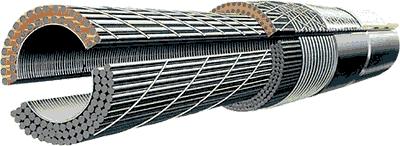
The spinning rod form has all the information you need to choose exactly what you need. Firstly, it indicates the material from which it was made. Fiberglass (FB), also known as fiberglass. The rods are quite heavy, less sensitive, but more durable and flexible. The most unpretentious material in terms of use, which is important if you like to go fishing as a “savage” and not just for one day.
Carbon (CARBON) is graphite, carbon fiber. It is worth mentioning right away that next to the Carbon marking there is usually a designation of the graphite module content. Denoted by the letters IM , which stands for Intermediate Modulus , and a number. For example, IM-6. And the higher this indicator, the more rigid and sensitive the spinning rod will be. At the same time, carbon rods are very light. However, there is also a minus - carbon fiber does not withstand impacts well, which causes cracks to appear on it, which increase under load.
Composite . This is a mixture of the already mentioned fiberglass, to which carbon is added, which provides good rigidity and increases the distance over which the bait can be cast.
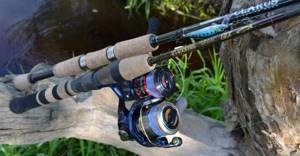
Kevlar . An artificial fiber with increased strength and, importantly, flexibility. Since it is a fiber, Kevlar itself is not used as a material, but is used for braiding fishing rods made of other materials. Most often, carbon fishing rods are braided with Kevlar to make it easier for them to withstand loads and impacts. This significantly increases the service life of the form. In such cases, if there is a Kevlar braid, on the form, in addition to the word Kevlar, a mesh created from this material will be visible.
Also, the form usually indicates the Class of the spinning rod and its Test. The test determines the minimum and maximum weight of the bait. And, depending on this indicator, the rod is assigned to one of the following classes:
- Ultra-Light (UL) , ultra light. Weight range 0-7 g.
- Light (L) , light, 3-15 g.
- Medium-Light (ML) . Rods with 5-20 grams of dough, medium light.
- Medium (M) - medium rods with bait weights of 7-30 g.
- Medium-heavy (MH) - medium-heavy. Designed for weight 15-40 g.
- Heavy (H) - heavy. Weight 20-80 grams.
Features of float fishing
The main feature here: fast and super-fast options are more expensive, both Bolognese and fly or match, and are used primarily by athletes in competitions, where every second is important when playing. Fast-action floats are additionally popular among this audience due to their minimal weight – a 13–14-meter plug rod made of high-modulus carbon can weigh about 800 grams.
Among amateurs, medium-action fishing rods have become more widespread, primarily for their versatility and light equipment: casting to the required distance is quite possible, and the blank compensates for jerks, and fairly rigid models can cope with forced fishing. At the same time, medium-fast fishing rods do not necessarily require the use of expensive materials, which has a positive effect on their availability.
Rods for carp fishing
Carp fishing has its own characteristics. First of all, for successful fishing it is considered necessary for the fisherman to have three types of rods at once: main, spod and marker. In this type, almost everything differs from the same feeder - from the choice of fishing location to feeding and the fishing itself. The selection of the main rod in most cases is based on approximately the same considerations as in feeder fishing, taking into account the characteristics of the place and fishing distance, as well as the individual preferences of a particular angler, but marker and spod rods have certain characteristics.
A spod is a heavy rod for casting large quantities of bait using rockets or spombs, often also over long distances. Most often, this is a powerful form with thick walls and fast action, since other options simply cannot cope with a similar task.
A marker rod is used to determine the depth and features of the bottom in the fishing area. It should be as sensitive as possible, with an informative tip, so most often marker fishing rods also have a fast action.
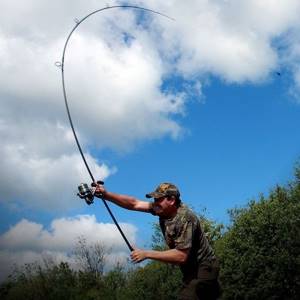
Carp fishing has its own characteristics. For example, the need for power, ultra-long casts, which places special demands on both the rod and the physical training of the fisherman.
Characteristics for spinning rods
Despite the fact that the features of the action are relevant for all types of fishing rods, in spinning fishing this parameter affects not only casting and retrieving, but also baits, as well as animation methods that are compatible with a specific version of the action. To describe it briefly:
- Fast and ultra-fast action is most suitable for jerking animation of wobblers, as well as silicone baits.
- Medium blanks are a kind of all-rounder that can handle a little bit of all types of lures.
- Slow-action spinning rods are well suited for rotating and oscillating spoons, small wobblers such as fat, shad and crank and are most often intended for trout fishing.
You can read more about the spinning rod structure, suitable baits, as well as how to animate them here.
Action is an important characteristic of any fishing rod; without taking this parameter into account, it is impossible to select the most effective tackle for specific fishing conditions. This property of the blank affects both the bait used and the casting distance and accuracy, as well as the number of fish landings.
How to choose a rod action?
When checking and choosing a rod action, it is necessary to take into account the straightening speed. When the spinning rod swings, its bending curve will change greatly, and from it you can determine the class of the action.
In the instructions on diagrams and plans, manufacturers indicate the structure of the spinning rod conditionally, so many fishermen check it themselves. Also, the system is determined by a series that takes into account rigidity, straightening speed, and bending arc.
For example, if a fishing rod is intended for catching perch (sea bass), then its action should be very rigid and the straightening time should be short. Dynamics and statics indicators are important for selection. Typically, fishermen are advised to purchase a spinning rod with universal functionality, suitable for different fishing methods and types of fish and bait.
The best option would be a universal fishing rod with a compacted blank, from a well-known manufacturer at the best price.
According to fishing methods, the division is usually as follows:
- Fast action is twitching, wiring with twitching;
- The medium action is a jig, jerking retrieves with wobblers and poppers;
- Slow action means even movements with wobblers.
It is impossible to accurately determine the class of the system. Fishermen often resort to various methods to test functionality. There is a need for information showing how fish behave when jerking.
Let's celebrate! When choosing a spinning rod, you need to clearly define its future tasks in order to avoid breaking the rod. The action indicators make it possible to determine its purpose and the weight of fish that it can support. All characteristics of the fishing rod can be found in the instructions, or you can go to the electronic resource and read information about each model.
